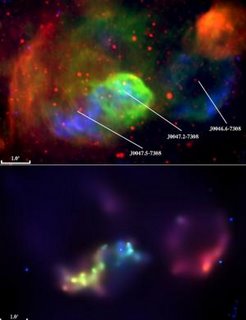Supernova Superbubbles

A superbubble of Supernova remnants in space, caught in the act of forming;
Found within the Small Magellanic Cloud -- a galactic neighbor of the Milky Way -- the large region of ionized hydrogen gas is designated "LHa115-N19," and "contains a number of massive stars and overlapping supernova remnants," said Rosa Williams, an astronomer at the University of Ilinois "We can tell there has been a fair amount of stellar activity going on."
From birth to death, massive stars have a tremendous impact on their surroundings. While alive, these stars generate stellar winds that push away nearby gas and dust, forming low-density cavities inside expanding bubbles. When the stars die, shock waves from their death throes can enlarge those bubbles into huge supernova remnants.
"In N19, we have not one star, but a number of massive stars blowing bubbles and we have several supernova remnants," Williams said. "Some of these cavities may overlap with one another. Eventually, these bubbles could merge into one enormous cavity, called a superbubble."
To identify the locations of massive stars, stellar-wind bubbles and supernova remnants in N19, Williams and colleagues combined optical images, X-ray data and spectroscopic measurements.
"We caught this particular region of N19 at a neat moment in time," Williams said. "The stars are just dispersed enough that their stellar winds and supernova blasts are working together, but have not yet carved out a full cavity. We are witnessing the birth of a superbubble."
Top picture: 3-color image showing emission in an optical hydrogen line taken at Cerro-Tololo Inter-American Observatory (red); radio data from the Australia Telescope Compact Array (green); and X-ray emission from the Chandra X-ray Observatory (blue).
Bottom picture: 3-color image showing X-ray emission at different energies: low (0.3-0.8 keV) in red, medium (0.8-1.5 keV) in green, and high (1.5-8.0 keV) in blue. The X-ray images have been adaptively smoothed.
(Photo courtesy Rosa Williams)
Centre for Theoretical Astrophysics - University of Illinois
Source: Science Daily Releases - 10th January 2007

This set of Chandra images shows evidence for a light echo generated by the Milky Way's supermassive black hole, a.k.a. Sagittarius A* (pronounced "A-star").
Astronomers believe a mass equivalent to the planet Mercury was devoured by the black hole about 50 years earlier, causing an X-ray outburst which then reflected off gas clouds near Sagittarius A*.
(NASA/CXC/Caltech/M.Muno et al.)
Read more Chandra Discovers Light Echo From The Milky Way's Black Hole
_______________________________________________________
_______________________________________________________
Labels: Chandra, Magellanic Cloud, Supernovae


<< Home